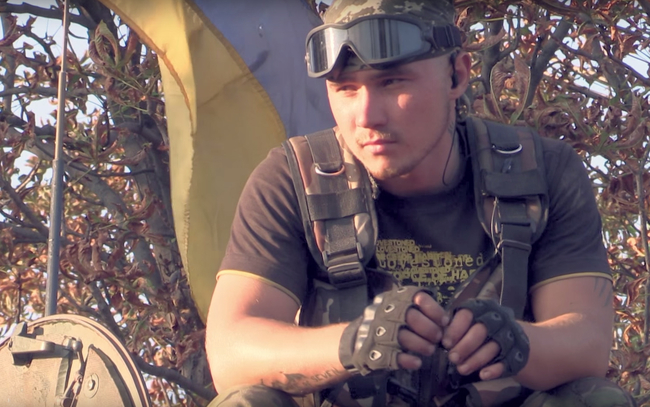The ATO Brotherhood
A National Guard soldier and actor, who became a volunteer, created a documentary about the war with his friends
“Right in front of us is the ‘Donetsk’ mine; it is located in the so-called neutral zone. We shall check it out now – if the blast does not go off, everything is quiet. And what if the bomb comes? – Then the film would have a very good shot (laughter) ... which we might not be able to see.” Those are the first words of the trailer of The ATO Brotherhood movie, created by Myroslav Hai, Serhii Lysenko, and Kostiantyn Mohylnyk. The first of them is an actor who became National Guard soldier, and then – a volunteer; the second is a director and screenwriter; the third is a traveler and writer. For almost a year and a half they had their “brotherhood,” going to the frontline, providing volunteer help, and writing down the stories of those who defended our ground. The ATO Brotherhood is composed of nine short stories about the war and occupation: the elections in the ATO zone; the volunteers and the National Guard; the sentiment in Donetsk and the fight in Pisky; the internally displaced persons and Crimea. But most importantly it offers stories of people to whom the war came knocking on the front door.
“After I was discharged from the National Guard, I returned to the frontline as a volunteer,” says Myroslav Hai, one of the movie co-creators, to The Day. “And then my fellow filmmakers Serhii Lysenko and Kostiantyn Mohylnyk offered to accompany me and make some footage. For a long time we were not able to determine the best format for all the material we captured, but the life itself has placed everything in order.” The military experience proved useful for Myroslav during the shooting, which required strict adherence to the combat discipline and the rules of military journalism. “Shooting and sharing a video must be done in a way so that it would not cause any harm,” explains the volunteer. “We never discouraged anyone from wearing a balaclava if they wanted to, but the vast majority of people in our film spoke boldly and openly.” According to the filmmaker, they had never went for candid shots, the camera started working only after meeting with the people and with their permission.
“In our small team we started to travel to the ATO zone, week after week preparing humanitarian aid at home and delivering it to the frontline,” says Hai. “For a year and a half we have been thus travelling and filming. We have wanted to create a large-scale documentary, but eventually realized that some guys we had filmed were already dead. The places we filmed had been changing sides – from us to the “LNR/DNR” and back. It became clear that we need to show something now, as perhaps in a year the film would be of no interest to anyone.”

Scene from The ATO Brotherhood movie
For the past year, the military heroism displayed on TV channels has turned into the usual routine. As the shelling very much continues in reality, in the media it drifted to the statistics, death from a mine is no longer seen as something extraordinary. Over time, new heroes of Ukraine appear, some even granted the official recognition, but how many of them do we know by name, not to mention their story? And do we remember any of those who died? “We were the first to film the Chechens who came here to fight for us, and General Isa Munayev, the famous field commander and the commandant of the Grozny Defense gave us the interview for the first time in Ukraine,” says Hai. “Then it was a resonant precedent – no one knew that the soldiers of Ichkeria were fighting for us... Isa Munayev is now dead, like many other guys.”
Later, in order to keep the memory of these people we began to share small fragments of the documentary online. Those were interviews with the guys from the frontline – soldiers near Pisky, Stanytsia Luhanska, Olkhovatka, and from the besieged areas. The frame captures internally displaced persons, National Guard soldiers, volunteers, Right Sector combatants, Armed Forces military men, volunteers, doctors... everyone who took part in the ATO in varying roles. “The film also features our front-line jokes, the songs we sang there, the small amusing stories. To some extent, our crew itself has turned into the characters of the movie,” recalls Hai. These documentary fragments of The ATO Brotherhood are already traveling the world. They were demonstrated at Boston University; they were at a road show in the US, organized by the “Voice of America” journalists; these fragments were also shown at the Goethe Institute in Germany (Goethe Institute endorsed the film project by a grant). According to the filmmakers, they have already received some festival offers, and the film is currently at the postproduction stage. The premiere is due in January 2016.
“The film’s characters are people, united for Ukraine’s victory over the occupiers, who treated each other as brothers,” concludes Hai. “The general purpose of the movie is to show a kaleidoscope of people’s fates inside the ATO zone. Everyone captured on film is either my acquaintance, or a comrade-in-arms, or someone I met at the frontline. There are soldiers with whom we broke the siege of Debaltseve together, or the soldiers for whom I waited in Artemivsk with the aid. All these people mean something to us; they somehow pass through our lives. This year has been very difficult but historically important for the country. The ATO Brotherhood is merely one of this period’s fragments; it is the period which neither we nor the country are even able to comprehend now. But we need to do it eventually.”
Newspaper output №:
№60, (2015)Section
Time Out





